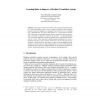Free Online Productivity Tools
i2Speak
i2Symbol
i2OCR
iTex2Img
iWeb2Print
iWeb2Shot
i2Type
iPdf2Split
iPdf2Merge
i2Bopomofo
i2Arabic
i2Style
i2Image
i2PDF
iLatex2Rtf
Sci2ools
ECML
2003
Springer
2003
Springer
Learning Rules to Improve a Machine Translation System
In this paper we show how to learn rules to improve the performance of a machine translation system. Given a system consisting of two translation functions (one from language A to language B and one from B to A), training text is translated from A to B and back again to A. Using these two translations, differences in knowledge between the two translation functions are identified, and rules are learned to improve the functions. Context-independent rules are learned where the information suggests only a single possible translation for a word. When there are multiple alternate translations for a word, a likelihood ratio test is used to identify words that co-occur with each case significantly. These words are then used as context in context-dependent rules. Applied on the Pan American Health Organization corpus of 20,084 sentences, the learned rules improve the understandability of the translation produced by the SDL International engine on 78% of sentences, with high precision.
| Added | 06 Jul 2010 |
| Updated | 06 Jul 2010 |
| Type | Conference |
| Year | 2003 |
| Where | ECML |
| Authors | David Kauchak, Charles Elkan |
Comments (0)

